[ 156 ]
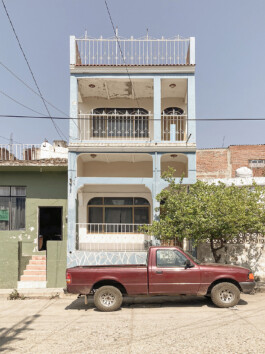
1
Inés Vachez (MX),
Remittance Architecture
Vista Hermosa, Mexico
(1) Please introduce yourself: What is your name, where are you from, what do you do?
My name is Inés Vachez, I am from Guadalajara, a city in western Mexico. I would describe myself as an urban researcher, writer, and photographer (in that particular order). Since 2020, I have had an urban research and independent publishing project called ↘︎ Analog Typologies. Education-wise, I am currently pursuing a second Master's in Social and Political Anthropology. I hold a Master's degree in Urban Typologies from the Technical University of Berlin and a Bachelor's degree in Architecture from ITESO and the Polytechnic University of Valencia.
(2) What is your relationship with photography and how did you get into it?
My mother gifted me her old Pentax K1000 about ten years ago, around the same time I started studying architecture. I began to be interested in photographing human traces in space, from objects and shadows to buildings and cities. In 2020, I founded my urban research and independent publishing project, Analog Typologies, in which I use visual anthropology, more specifically photography, to open debates and reflect on urban phenomena.
(3) What do you think triggers you to photograph in a certain moment? Is it planned or solely driven by intuition?
I would say my approach to photography is strongly intuitive. I have very empirical knowledge about how a camera works; for me, it is merely a tool. A tool to remember something that triggered my curiosity, to take with me something I liked, or to portray an idea that goes beyond the sole composition of a picture. I am also very selective with my shots; that is why I almost only shoot film. I just have a hunch «this place or this moment is worth a shot.»
(4) What is the story you want your pictures to tell?
Most of the time, the pictures I display are there to illustrate a particular idea or narrative. For instance, I wanted to talk about how Japanese culture has a very meticulous, almost ritualistic, time and space management. So I began shooting something that, I thought, was the absolute antithesis of this spatial-temporal philosophy, therefore helping me make my point. (I am talking about street vending machines, but this is a story for another time).
(5) Which city would you like to visit the most, and why?
That is a very hard question. Many different cities are on my list, and the reasons why I want to visit them are as manifold and numerous as the cities themselves. But if I had to choose one city that is among my travel plans for the next couple of years, I would say Johannesburg. I am planning on heading to the southern countries of Africa sometime soon, and that would be a city to begin my trip with.
(6) What is your personal relationship to cities and how do you perceive them as places in general?
I would dare to use the word «passionate». They are somehow both my origin and my destination, the means and the goal. I hate them as much as I love them. I want to understand them while, at the same time, I see the «malaises» and the harm in them.
(7) Regarding your project Remittance Architecture: What was your intention, and how did you come up with the idea?
For me, the study of the Mexican countryside was an important way to understand the general development of the country and, hence, its cities. Remittance architecture is the term used to refer to any object in the built environment whose construction was funded using remittances (the money that a migrant sends back to their home country). The impact of immigration to the US on Mexican society is titanic, and as an urban researcher and anthropologist, it is clear to me that there is no change in society that doesn't end up being reflected in its built environment. Remittance Architecture is a photographic series that illustrates a book by the same name. It tells the story of a small town in the south of Jalisco (the region I am originally from) named Vista Hermosa, and how migration transformed it completely. It is also a story about colonialism, emancipation, empowerment, and freedom. I wanted to tell their story and to show the value behind these houses that are the symbol of a long-pursued freedom.
(8) Which project did you never finish?
I actually tend to be very disciplined with finishing something I start, or at least giving it closure. I have a lot of story drafts and pictures from the years I was living in Berlin, and I have been planning on making a book with them for a couple of years now, but I never seem to find the time to dedicate myself to it. But between now and never, there is a very long time, so I like to think I am going to finish that project at some point.
(9) What is that «one thing» you have never managed to photograph and is now gone for good?
I can only think of one, and it breaks my heart: The Metabolist Capsule Building in Tokyo, which was dismantled a couple of years ago.
(10) If you could travel back / forth in time, what advice would you give your younger / older self?
I would tell her to never stop «making» things, having projects, going places, starting conversations. That is the drive that will keep her moving and give her a sense of fulfilment in life.
(11) What do you prefer saying: To «take a photograph» or to «make a photograph», and why?
I had never thought about it. But given my approach to it, I would say «take,» as I am «taking» something from a place and a time, carrying it with me.
(12) What is the most interesting experience you have had while photographing?
I don't go and photograph something or somewhere; it is more like I photograph as I go. Yet, I do have a good anecdote. There is a town in the southern part of Mexico called San Juan Chamula, where many very unusual syncretic religious rites take place. It is known that one must not make pictures of the inside of their temple, and that the Chamulas do not like to be approached and photographed. From afar, I was seeing them do a dance outside of their temple while throwing firecrackers into the air. I decided to take a quick shot from a safe distance, thinking that it would go unnoticed. When I placed my eye on my camera's viewfinder, I saw a firecracker heading right towards me. I managed to dodge it, and it exploded a couple of meters behind me. I turned around to look at the person who had thrown it, and he looked back at me with a defiant look. I knew it had been my bad, so I just apologized with a nod and put away my camera in my bag.
(13) If it wasn’t for photography, what would you be interested in doing instead?
I believe I would find other means to portray the places I visit and inhabit. Curiosity always triggers creative ways of understanding and translating our experiences into something else.
(14) How would you describe one of your pictures to a visually impaired person?
I'll describe the first picture of my Remittance Architecture series: It is morning, and the remnants of irrigation water from the nearby park still trickle down the street, leaving a fresh scent in the air. In front of us stands a grand, imposing house, its presence accentuated by a network of black electricity cables overhead. Instead of a solid fence, there is only a boundary separating the house from the sidewalk, allowing pedestrians to glimpse the four levels of the elegant structure. A red and silver car parked in front of the house appears diminutive in comparison, emphasizing the scale of the residence. The house exudes a commanding presence; its impeccable ivory-white facade reflects the light of the pale blue sky, almost forcing one to squint when gazing at it directly. The ornamentation is subtle yet refined; cement moldings and gentle curves adorn the numerous windows, doors, and balustrades. To enter the house, one must ascend several steps, leading to a carved wooden door sheltered by a porch supported by four Doric columns.
(15) What are you currently working on, and—if there is—what is your next project or journey?
I want to begin documenting the water scarcity problem in Mexico City, where I am based right now. Water stress is a global problem, and it manifests itself not only in the form of a dry and sterile territory but also in many social dynamics. This 30 million inhabitant city is about to reach the «zero hour» of water supply. My goal is to document the scarcity in the urban landscape.
Thank you, Inés.
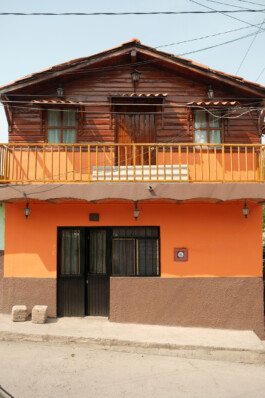
2

3

4

5
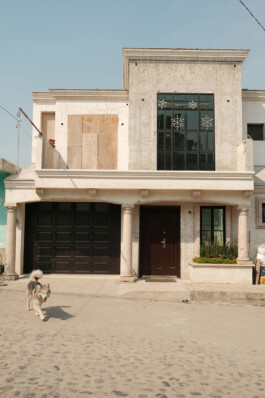
6

7
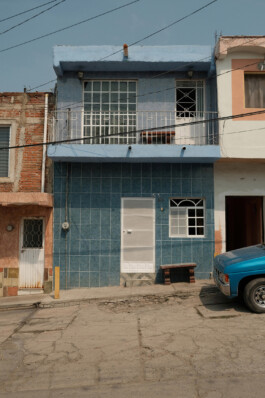
8

9

10

11

12
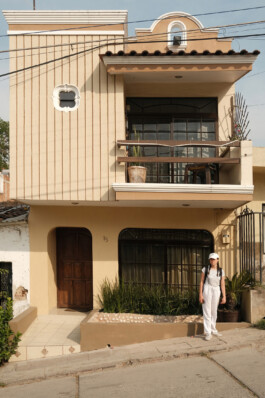
13
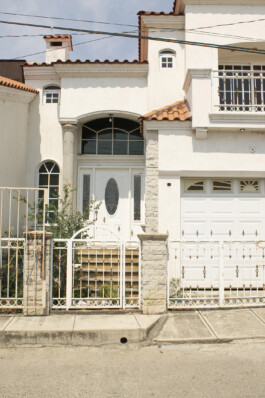
14

15

16
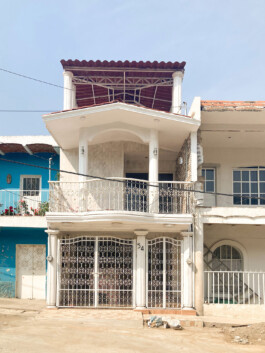
17
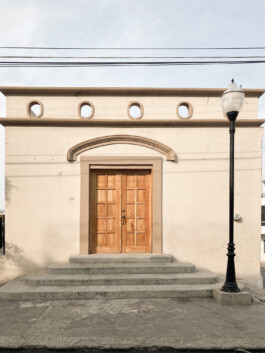
18
Images
1–18 Inés Vachez, Remittance Architecture, Vista Hermosa, Mexico, 2021–2024.
Interview

1
Inés Vachez (MX),
Remittance Architecture
Vista Hermosa, Mexico
(1) Please introduce yourself: What is your name, where are you from, what do you do?
My name is Inés Vachez, I am from Guadalajara, a city in western Mexico. I would describe myself as an urban researcher, writer, and photographer (in that particular order). Since 2020, I have had an urban research and independent publishing project called ↘︎ Analog Typologies. Education-wise, I am currently pursuing a second Master's in Social and Political Anthropology. I hold a Master's degree in Urban Typologies from the Technical University of Berlin and a Bachelor's degree in Architecture from ITESO and the Polytechnic University of Valencia.
(2) What is your relationship with photography and how did you get into it?
My mother gifted me her old Pentax K1000 about ten years ago, around the same time I started studying architecture. I began to be interested in photographing human traces in space, from objects and shadows to buildings and cities. In 2020, I founded my urban research and independent publishing project, Analog Typologies, in which I use visual anthropology, more specifically photography, to open debates and reflect on urban phenomena.
(3) What do you think triggers you to photograph in a certain moment? Is it planned or solely driven by intuition?
I would say my approach to photography is strongly intuitive. I have very empirical knowledge about how a camera works; for me, it is merely a tool. A tool to remember something that triggered my curiosity, to take with me something I liked, or to portray an idea that goes beyond the sole composition of a picture. I am also very selective with my shots; that is why I almost only shoot film. I just have a hunch «this place or this moment is worth a shot.»
(4) What is the story you want your pictures to tell?
Most of the time, the pictures I display are there to illustrate a particular idea or narrative. For instance, I wanted to talk about how Japanese culture has a very meticulous, almost ritualistic, time and space management. So I began shooting something that, I thought, was the absolute antithesis of this spatial-temporal philosophy, therefore helping me make my point. (I am talking about street vending machines, but this is a story for another time).
(5) Which city would you like to visit the most, and why?
That is a very hard question. Many different cities are on my list, and the reasons why I want to visit them are as manifold and numerous as the cities themselves. But if I had to choose one city that is among my travel plans for the next couple of years, I would say Johannesburg. I am planning on heading to the southern countries of Africa sometime soon, and that would be a city to begin my trip with.
(6) What is your personal relationship to cities and how do you perceive them as places in general?
I would dare to use the word «passionate». They are somehow both my origin and my destination, the means and the goal. I hate them as much as I love them. I want to understand them while, at the same time, I see the «malaises» and the harm in them.
(7) Regarding your project Remittance Architecture: What was your intention, and how did you come up with the idea?
For me, the study of the Mexican countryside was an important way to understand the general development of the country and, hence, its cities. Remittance architecture is the term used to refer to any object in the built environment whose construction was funded using remittances (the money that a migrant sends back to their home country). The impact of immigration to the US on Mexican society is titanic, and as an urban researcher and anthropologist, it is clear to me that there is no change in society that doesn't end up being reflected in its built environment. Remittance Architecture is a photographic series that illustrates a book by the same name. It tells the story of a small town in the south of Jalisco (the region I am originally from) named Vista Hermosa, and how migration transformed it completely. It is also a story about colonialism, emancipation, empowerment, and freedom. I wanted to tell their story and to show the value behind these houses that are the symbol of a long-pursued freedom.
(8) Which project did you never finish?
I actually tend to be very disciplined with finishing something I start, or at least giving it closure. I have a lot of story drafts and pictures from the years I was living in Berlin, and I have been planning on making a book with them for a couple of years now, but I never seem to find the time to dedicate myself to it. But between now and never, there is a very long time, so I like to think I am going to finish that project at some point.
(9) What is that «one thing» you have never managed to photograph and is now gone for good?
I can only think of one, and it breaks my heart: The Metabolist Capsule Building in Tokyo, which was dismantled a couple of years ago.
(10) If you could travel back / forth in time, what advice would you give your younger / older self?
I would tell her to never stop «making» things, having projects, going places, starting conversations. That is the drive that will keep her moving and give her a sense of fulfilment in life.
(11) What do you prefer saying: To «take a photograph» or to «make a photograph», and why?
I had never thought about it. But given my approach to it, I would say «take,» as I am «taking» something from a place and a time, carrying it with me.
(12) What is the most interesting experience you have had while photographing?
I don't go and photograph something or somewhere; it is more like I photograph as I go. Yet, I do have a good anecdote. There is a town in the southern part of Mexico called San Juan Chamula, where many very unusual syncretic religious rites take place. It is known that one must not make pictures of the inside of their temple, and that the Chamulas do not like to be approached and photographed. From afar, I was seeing them do a dance outside of their temple while throwing firecrackers into the air. I decided to take a quick shot from a safe distance, thinking that it would go unnoticed. When I placed my eye on my camera's viewfinder, I saw a firecracker heading right towards me. I managed to dodge it, and it exploded a couple of meters behind me. I turned around to look at the person who had thrown it, and he looked back at me with a defiant look. I knew it had been my bad, so I just apologized with a nod and put away my camera in my bag.
(13) If it wasn’t for photography, what would you be interested in doing instead?
I believe I would find other means to portray the places I visit and inhabit. Curiosity always triggers creative ways of understanding and translating our experiences into something else.
(14) How would you describe one of your pictures to a visually impaired person?
I'll describe the first picture of my Remittance Architecture series: It is morning, and the remnants of irrigation water from the nearby park still trickle down the street, leaving a fresh scent in the air. In front of us stands a grand, imposing house, its presence accentuated by a network of black electricity cables overhead. Instead of a solid fence, there is only a boundary separating the house from the sidewalk, allowing pedestrians to glimpse the four levels of the elegant structure. A red and silver car parked in front of the house appears diminutive in comparison, emphasizing the scale of the residence. The house exudes a commanding presence; its impeccable ivory-white facade reflects the light of the pale blue sky, almost forcing one to squint when gazing at it directly. The ornamentation is subtle yet refined; cement moldings and gentle curves adorn the numerous windows, doors, and balustrades. To enter the house, one must ascend several steps, leading to a carved wooden door sheltered by a porch supported by four Doric columns.
(15) What are you currently working on, and—if there is—what is your next project or journey?
I want to begin documenting the water scarcity problem in Mexico City, where I am based right now. Water stress is a global problem, and it manifests itself not only in the form of a dry and sterile territory but also in many social dynamics. This 30 million inhabitant city is about to reach the «zero hour» of water supply. My goal is to document the scarcity in the urban landscape.
Thank you, Inés.

2

3

4

5

6

7

8

9

10

11

12

13

14

15

16

17

18
Images
1–18 Inés Vachez, Remittance Architecture, Vista Hermosa, Mexico, 2021–2024.